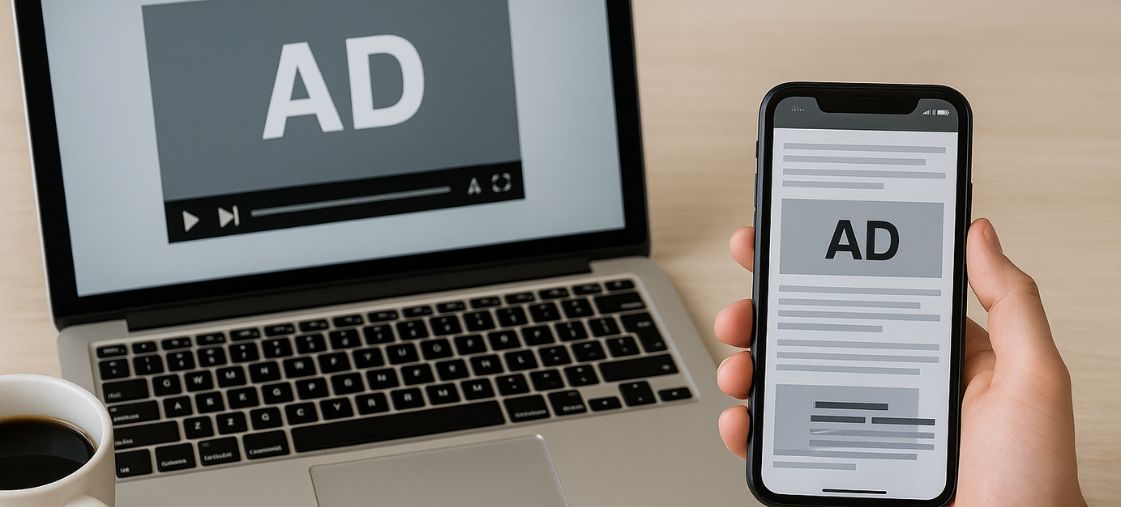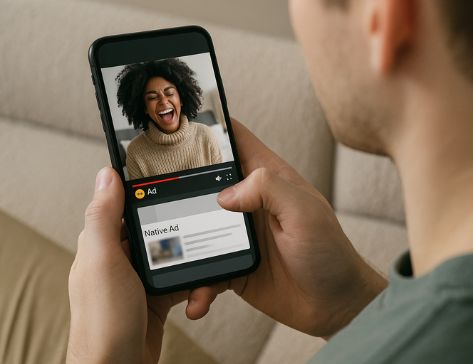
InStream Ads vs Native Ads: When to Use Each
InStream ads vs native ads are two high-performing formats that marketers often compare when planning campaigns across the funnel, yet each shines under different conditions and creative strategies.
InStream ads typically appear before (pre-roll), during (mid-roll), or after (post-roll) video content, and they command attention through sound and motion in a captive environment. If you’re new to the format, this short in‑stream ads guide is a useful primer on placements and specifications.
Native ads, by contrast, blend into the surrounding editorial or feed environment with matching typography, layout, and tone. The goal is to reduce disruption, boost relevance, and encourage curiosity-driven clicks or engagement that feels organic rather than overtly promotional.
Choosing between the two isn’t a binary decision—it’s about context, creative, and intent. In attention-scarce environments, strong openings matter; frameworks that help you craft a compelling first three seconds can dramatically improve watch rates and conversions—see these ideas on 3‑second hook frameworks to sharpen your approach.

Why this comparison matters
Digital ad budgets are increasingly tied to clear business outcomes. Because formats carry different user expectations and interaction patterns, aligning your ad type to your objective is one of the fastest ways to improve efficiency. Think of formats as tools in a kit: you wouldn’t use a hammer for a screw. Similarly, you shouldn’t use a high-attention, interruptive video spot to drive subtle consideration when a context-fitting native placement might do the job better and cheaper.
What are InStream ads?
InStream placements run adjacent to video content on social platforms, streaming services, and publisher sites. They can be skippable or non-skippable and often include companion CTAs or end cards. Their superpower is forced opportunity: for a brief window, you reliably earn attention with sight, sound, and motion.
Strengths
- Rapid reach and recall: Excellent for launches, promotions, and brand lifts where memorability matters.
- Emotional storytelling: Sound and pacing enable narrative arcs and product demos that text or static cannot convey.
- Precise objectives: Optimizable for views, completed views, clicks, and conversions with sophisticated targeting.
Limitations
- Creative pressure: Weak openings burn budget. If the hook fails, users skip and you lose the moment.
- Perceived intrusion: Interruptive nature can irritate users, especially if frequency caps aren’t managed.
- Higher production effort: Quality audio, editing, and motion design add cost and time.
When to use InStream
- Top‑ and mid‑funnel initiatives: Drive awareness, lift consideration, or reframe category beliefs.
- Demonstration-heavy products: You need to show outcomes, use-cases, or before/after transformations.
- Seasonal or time‑sensitive offers: Rapid reach over a short window is critical.
InStream creative checklist (use this before launching)
- Open with motion and product clarity in the first 3 seconds.
- Introduce brand cues early (logo, sonic branding, distinctive assets).
- Design for sound‑off with captions and on‑screen text.
- Use tight framing and large typography for mobile screens.
- Front‑load value (benefit ➜ proof ➜ CTA) in 15 seconds or less.
- Test skippable vs non‑skippable edits; optimize hook density accordingly.
What are Native ads?
Native ads are designed to match the form and function of the page or feed in which they appear. Headlines, thumbnails, and copy are tuned to the audience’s intent and the surrounding content, which yields higher relevance and a smoother user experience.
Strengths
- Contextual alignment: Fits the user journey; works well for education, comparison, and soft conversion.
- Scalable variations: You can test dozens of headlines and images quickly with low production overhead.
- Lower friction: Less interruptive; often higher CTR at competitive CPCs when well targeted.
Limitations
- Weaker top‑of‑funnel impact: Harder to build emotional memory without video or audio.
- Platform dependence: Performance varies with supply quality, widgets, and publisher integrity.
- Creative fatigue risk: Headlines/images wear out; requires ongoing iteration cadence.
When to use Native
- Mid‑ to lower‑funnel objectives: Drive qualified traffic to articles, product pages, or advertorials.
- Consideration and research phases: Nurture with educational content, comparisons, or buyer’s guides.
- Always‑on acquisition: Maintain steady pipeline with iterative creative testing.
Native creative checklist (before you scale)
- Mirror the platform voice; avoid clickbait—promise only what the page delivers.
- Lead with a vivid benefit or tension (problem ➜ implication ➜ solution).
- Use curiosity gaps ethically: ask a question the landing page fully answers.
- Align thumbnail imagery with headline promise and landing‑page hero.
- Include clear next steps on the page (CTA, proof, FAQs, risk‑reversal).
A simple decision framework
- Define your core KPI: Awareness (reach, VTR), consideration (CTR, time on page), or conversion (CPL/CPA).
- Map audience intent: Cold, warm, or hot? InStream is strong for cold reach; native excels at warming and nudging.
- Assess creative assets: Do you have a compelling video hook? If not, native might be faster to test and learn.
- Estimate unit economics: Model CPV/CPC ➜ CTR ➜ CVR ➜ CPA to find the efficient frontier.
- Pilot, then dual‑track: Start with the best‑fit format, then layer the other to complement journey stages.
Budgeting and measurement
Set KPIs and guardrails before launch. For InStream, track view rate (VTR), cost per completed view (CPCV), and assisted conversions. For native, track click‑through rate (CTR), cost per click (CPC), and on‑site quality metrics like bounce rate, scroll depth, and time on page.
Useful formulas
- View‑to‑click rate (VCR): clicks ÷ views
- Click‑to‑lead rate (CTL): leads ÷ clicks
- Lead‑to‑sale (LTS): sales ÷ leads
- Cost per acquisition (CPA): spend ÷ sales
- Blended CAC: total marketing spend ÷ new customers in period
Creative best practices that lift both formats
For InStream
- Hook density: Place 2–3 micro‑hooks in the first 6–8 seconds (unexpected visual, bold claim, fast demo).
- Modular editing: Create 6s, 10s, 15s cuts to match placements and test pacing.
- Social proof overlays: Star ratings, review snippets, and “as seen in” logos can boost credibility mid‑view.
- CTA sequencing: Tease benefit early, invite action mid‑video, reinforce at end card.
For Native
- Headline frameworks: “How X achieves Y,” “X vs Y comparisons,” or “Mistakes to avoid.”
- Image testing plan: People + product, clean infographic, or contextual lifestyle—rotate weekly.
- Pre‑qualification: Include price, timeframe, or requirement to reduce low‑intent clicks.
- Land page message match: Keep headline words consistent with the ad to reduce drop‑off.
Common pitfalls and how to avoid them
- Misaligned objectives: Pushing immediate sales with a cold InStream audience often inflates CPA. Warm them first.
- Thin landing pages: Native traffic needs depth—comparisons, objections, FAQs, and proof.
- Under‑testing hooks: Creative variance, not targeting, is the biggest driver of performance swings.
- Ignoring frequency: Cap InStream exposure to avoid ad fatigue; refresh native creatives regularly.
Practical examples
Scenario 1: New product launch
Start with InStream to build awareness quickly: produce a 15‑second hero cut with three crisp benefits, then retarget viewers (25–50% completions) with native advertorials and comparison pages. This sequencing lifts assisted conversions and reduces wasted impressions.
Scenario 2: High‑consideration B2B offer
Use native ads to drive traffic to a well‑structured guide or webinar that educates and captures leads. Later, run short InStream case‑study snippets to re‑engage your warm audience and push them toward demo requests.
Scenario 3: Performance ceiling on one format
If InStream CPAs rise, introduce native to harvest demand among users who prefer to read before watching. If native CTR stagnates, test short, punchy InStream creatives to broaden reach and feed your retargeting pools.
Conclusion
In sum, you don’t need to pick a permanent winner in the debate of InStream ads vs native ads. Treat each format as a specialist: InStream for rapid attention and narrative persuasion; native for contextual education and efficient acquisition. Set clear KPIs, design creatives to the medium, and iterate weekly. To deepen your analysis and discover competitive angles, explore an InStream ad intelligence tool and note how top performers structure hooks, value props, and landing pages. When you align format to intent and creative to placement, you’ll compound results across the funnel.


